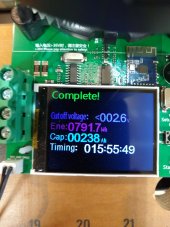Horsefly
Solar Wizard
SORRY, THIS ITEM IS SOLD!
This little cell capacity tester works pretty well. I would keep it, but bought a way over-priced better tester.
I purchased it here: https://www.aliexpress.com/item/1005001458325206.html
It connects to a cell (or - I guess - a full battery pack, but I haven't tried that) measures the Ah capacity of that cell. Simple as that. This one is like many of the other similar testers, but it has a few features that many don't: (1) It's got a cool color display, rather than the boring green display, (2) It has a Bluetooth interface, so you can monitor from you phone (app download is included), (3) it has a USB PC interface, so you can monitor / log the cell discharge on you laptop (download PC app is included), and (4) it has a little adaptor thing to allow you to measure stuff associated with power supplies (I never used any of this, so can't vouch for how it works).
I'm including the device itself, it's power supply, the user manual (useful only to see how to program it, the adaptor to measure power supplies, the QR code to get the apps and softcopy of the manual, and my much improved (over what they sent) cables to connect to your cell. These are all shown in the attached photo. I've also included a couple of attached photos of it during a capacity test, and at the conclusion.
One note: It measures the voltage of the cell about 60mV high. This is of no consequence for LiFePO4 cells. Since there is essentially no energy left in the cell between 2.5V and 2.6V, I just set the cutoff to 2.6V, and I know the measurement is good. It works great!
On Aliexpress it's now $47 and change (I think I paid over $50 for it), but... I'm not looking to make any money. I just would rather my friends here on the board benefit from it rather than me tossing it in the trash! I'm looking for $25 plus UPS ground shipping costs, which shouldn't be much. Give me an offer, and I'll consider it!
Send me a PM if interested. Thanks!
This little cell capacity tester works pretty well. I would keep it, but bought a way over-priced better tester.
I purchased it here: https://www.aliexpress.com/item/1005001458325206.html
It connects to a cell (or - I guess - a full battery pack, but I haven't tried that) measures the Ah capacity of that cell. Simple as that. This one is like many of the other similar testers, but it has a few features that many don't: (1) It's got a cool color display, rather than the boring green display, (2) It has a Bluetooth interface, so you can monitor from you phone (app download is included), (3) it has a USB PC interface, so you can monitor / log the cell discharge on you laptop (download PC app is included), and (4) it has a little adaptor thing to allow you to measure stuff associated with power supplies (I never used any of this, so can't vouch for how it works).
I'm including the device itself, it's power supply, the user manual (useful only to see how to program it, the adaptor to measure power supplies, the QR code to get the apps and softcopy of the manual, and my much improved (over what they sent) cables to connect to your cell. These are all shown in the attached photo. I've also included a couple of attached photos of it during a capacity test, and at the conclusion.
One note: It measures the voltage of the cell about 60mV high. This is of no consequence for LiFePO4 cells. Since there is essentially no energy left in the cell between 2.5V and 2.6V, I just set the cutoff to 2.6V, and I know the measurement is good. It works great!
On Aliexpress it's now $47 and change (I think I paid over $50 for it), but... I'm not looking to make any money. I just would rather my friends here on the board benefit from it rather than me tossing it in the trash! I'm looking for $25 plus UPS ground shipping costs, which shouldn't be much. Give me an offer, and I'll consider it!
Send me a PM if interested. Thanks!
Attachments
Last edited:





